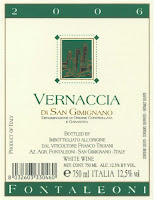If Chianti is regarded as one of Italy's most popular wine, then Brunello is surely one of Italy's most renowned. In contrast to it's neighbouring wines of Chianti, Brunello is made from 100% pure Sangiovese grapes. Feruccio Biondi-Santi was credited with Brunello's creation when he officially bottled his first Brunello di Montelcino in 1988. Biondi-Santi used carefully selected vines to produce his wines, his stringent eye for quality led Tuscan vintners to refer to his grapes as Sangiovese Grosso, as they believed them to be so much better than Sangiovese that they couldn't be the same variety. Biondi-Santi began to produce Brunello with strong flavour, which was characterised by strong tannins when young but these would soften greatly with age to develop an aromatic bouquet of spice, leather and sweet tobacco.
Unfortunately, for a long time DOC regulations forced winemakers to mature their Brunello for four, sometimes five, years in large wooden casks. This bulk maturation led to weaker vintages of Brunello to become even thinner and completely loose it's luster and charm. Nowadays, a shorter period of maturation is used and winemakers now use smaller barrique-style barrels which has led to Brunello's much more modern appearance. Under new DOC regulations the lesser wines of Brunello are now sold under the name Rosso di Montalcino. Rosso di Montepulciano is stronger than the other second wines of the region, it's flowery bouquet and firm, but not harsh, tannins place good Rosso di Montalcino somewhere between a good Chianti and Brunello and is more than a great match for the local Chiana beef steak.
A Noble Wine
In and around the small town of Montepulciano, Sangiovese is known as Prugnolo Gentile, the main wine produced in Montepulciano is Vino Nobile di Montepulciano. This small, medieval town stands alone overlooking the Chiana Valley - famous for it's cattle - and above the Lago Tresimano, both of which give the region an excellent micro climate for Sangiovese vines.
The Oldest DOC In The World
Carmignano is grown on the hills overlooking western Florence, and its wines were protected as far back as 1716 by Cosimo III by a designation of origin, possibly the first DOC wine in Italy, and maybe even the first appellation in the world. Carmignano was also the first wine region in Italy to use non-native, specifically French, grape varieties, it's DOC shows the first officially permitted use of Cabernet Sauvignon. With regards to its strength and substance, Carmignano can be compared to Nobile di Montepulciano. Good vintages made by top producers can be aged for several decades.
In the Carmignano area there is also a second wine with DOC status called Barco Reale di Carmignano which contains no Cabernet Sauvignon, but only Sangiovese and another native Tuscan grape variety called Canaiolo.
The Second Great Tuscan
Revolution
For many years, in wine growing terms anyway, the Tuscan coast between Livorno and Grosetto was a kind-of viticultural no-mans land. For many years the only DOC wine was a rose from Bolgheri.
But the late 1970s saw a revolution, great advances in table wines were made in the region by a table wine, Sassicaia. The revolution was so great Sassicaia seemed destined to become the most famous Italian wine produced from a single, non-native grape variety, grape variety. Sassicaia is made from 100% pure Cabernet Sauvignon vines, imported directly from Bordeaux by Count Incisa delle Rochetta.
Sassicaia's success led to the greatest form of flattery, imitation. Neighbouring areas began to experiment with Cabernet varieties, some even had great success.
Ornellaia made wines from a blend of Cabernet Sauvignon, Cabernet Franc and Merlot. Other areas which experimented with Cabernet varieties included Grattamacco, which produced a successful blend of Cabernet varieties with the native Sangiovese variety. Changes to the DOC regulations have led to the wines of this region being allowed to label themselves as DOC wines, rather than just Vino di Tavola, acquiring a seal and guarantee of quality.
White Wines of San Gimigiano
The regions most famous white wine is probably San Gimigiano. Grapes have been cultivated in this area since the 13th century, and Vernaccia was was Italy's first white wine to be awarded DOC status. These dry and slightly aromatic wines are great accompaniment to the local pasta and fish dishes. Recently the red wines of San Gimigiano have been awarded DOC status and are showing well in many national and international wine shows.
Other Smaller Designated Areas
Over the last 10 years Tuscany's southern province of Grosetto has grown into a dynamic, up and coming wine producing region, until recently only the Morellino di Scansano, a Sangiovese based wine and the lighter Bianco di Pitigliano were made here. Since the 1990s the region has seen an upsurge in wine production. Hundreds of hectares have been replanted with vines, non native varieties such as Merlot now grow side by side with the local, historical, Sangiovese variety which can both be blended with excellent results.
The white wines of the Montecarlo region in Lucca northern Tuscany and Pomino in the mountains above the Chianti Ruffina region now produce stunning white wines. Pomino is now also pressing red wines from varieties such as Merlot, Cabernet and Sangiovese, all with excellent results. Non-native white varieties such as Chardonnay now grow side by side with native Trebbiano, both of which are now produced separately and as a blend to produce some crisp, fresh, somewhat traditional tasting wines.






No comments:
Post a Comment